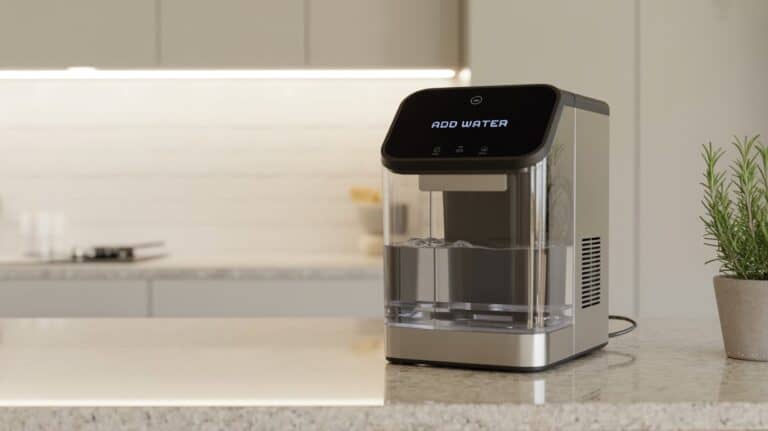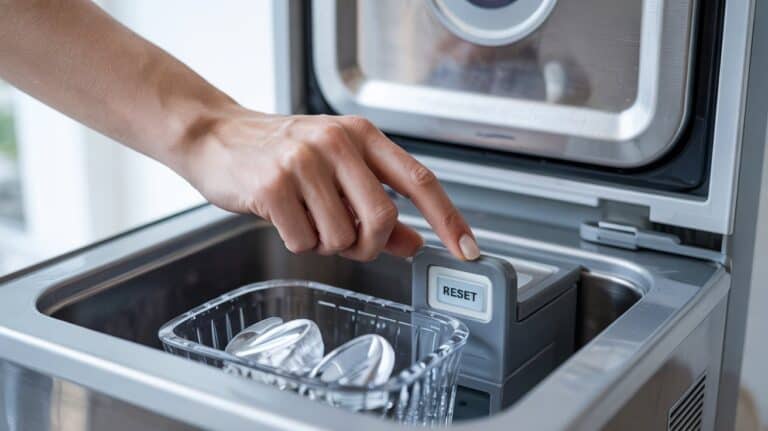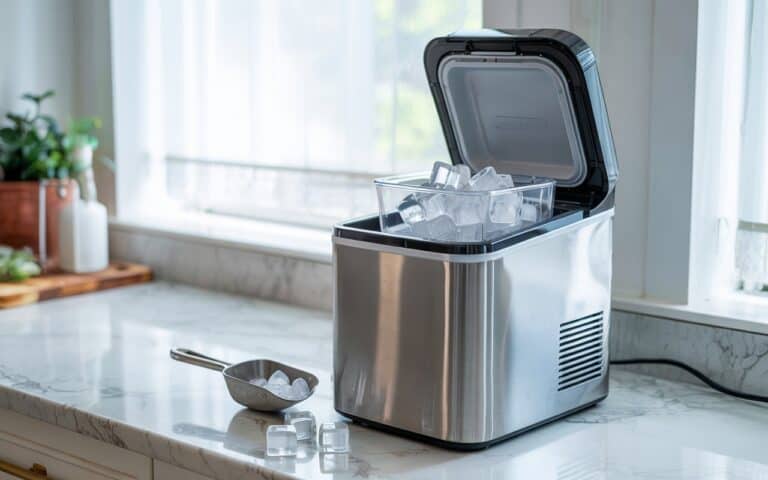How Does an Ice Maker Work? (Clear, Simple Guide)
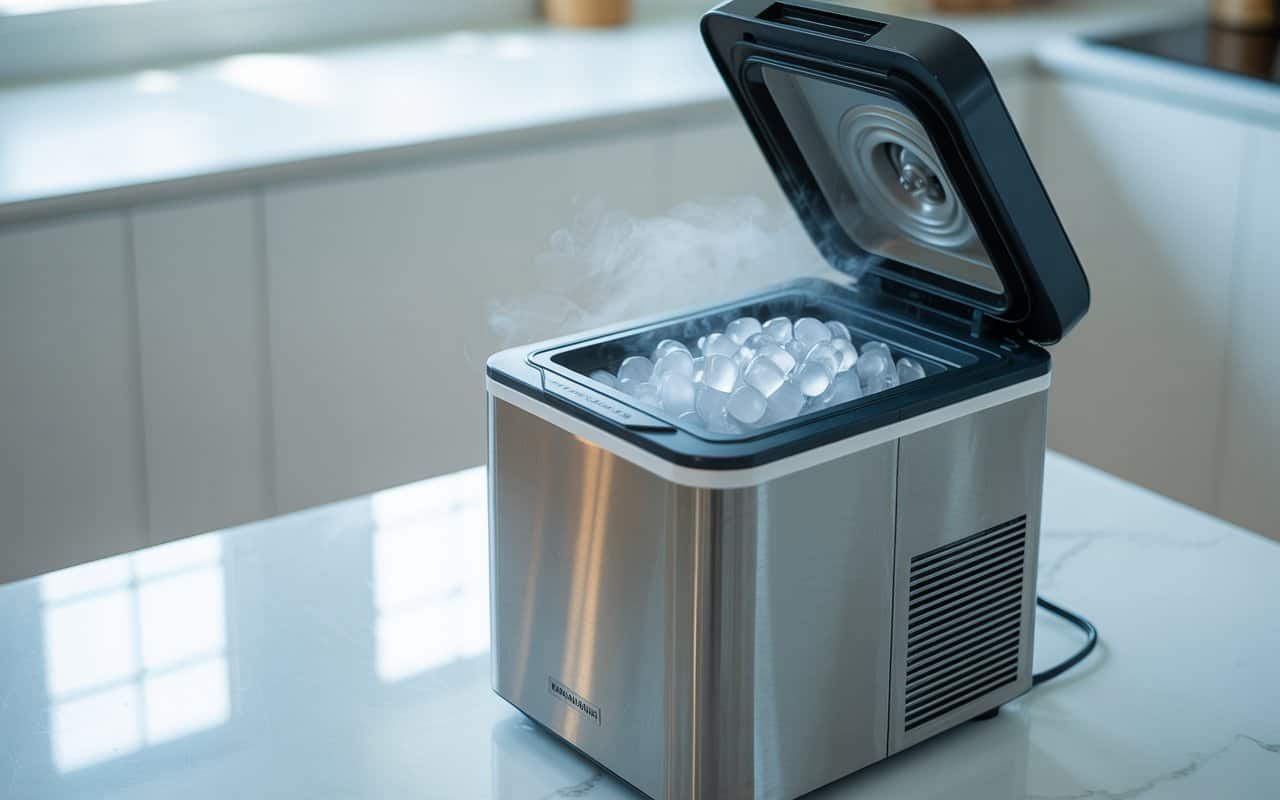
Have you ever wondered how an ice maker turns water into solid cubes in just minutes?
Whether it’s inside your fridge or on your kitchen counter, every ice maker follows a fascinating (and surprisingly simple) process.
In this guide, I’ll walk you through exactly how ice makers work, what happens inside, and what makes each type unique—without any technical jargon.
The Basic Science Behind Ice Making
At the core of every ice maker is a refrigeration cycle—a controlled process that pulls heat away from water until it freezes. The system uses a compressor, cooling coils, and refrigerant gas to reach the ideal temperature where ice can form quickly.
Now, you might wonder: How is this different from just putting a tray in the freezer?
With natural freezing, water solidifies slowly and unevenly. But in a machine, ice forms faster, cleaner, and in consistent shapes, thanks to direct contact with super-cooled metal surfaces.
🧊 Note:
The way ice is made inside a machine affects its texture and clarity—which is why machine-made cubes are often clearer than homemade ones.
Key Components Inside Any Ice Maker
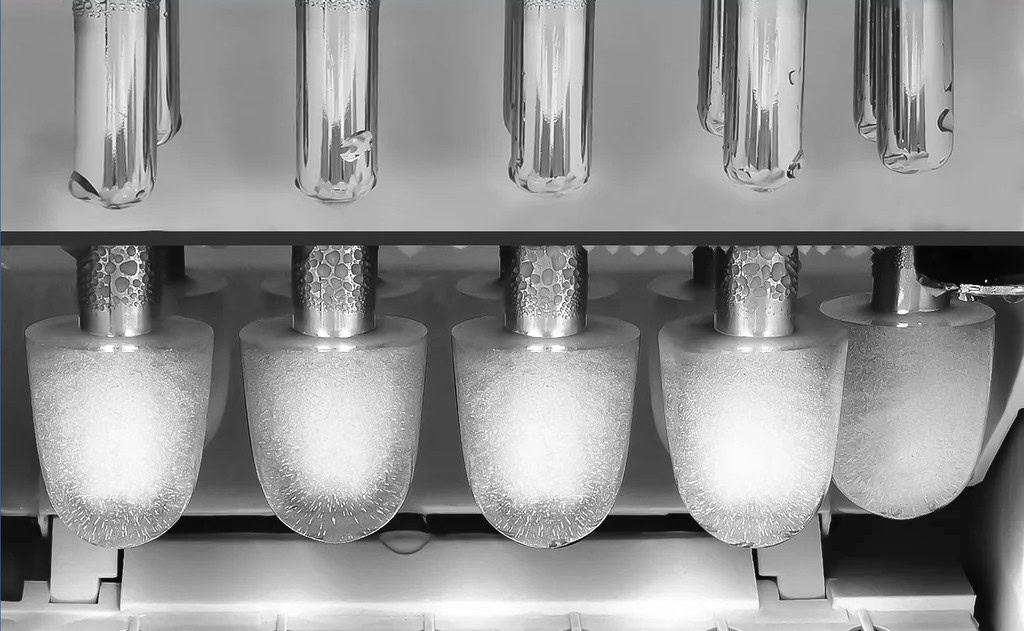
Every ice maker—whether it’s in your fridge or a standalone unit—relies on a few core parts working together.
- Water Reservoir: This is where the machine pulls water from. If it’s empty or dirty, the whole process stops.
- Ice Tray or Mold: Water fills into a specific shape here, whether it’s crescent, bullet, or cube-style ice.
- Cooling Element: These are usually metal coils or plates that freeze the water quickly and evenly.
- Heating Element: Sounds odd in an ice machine, right? But it’s needed to slightly warm the tray and release the frozen cubes cleanly.
- Sensors and Timers: These control the cycle automatically—filling, freezing, and releasing—without you lifting a finger.
One common issue with misshapen or slow-forming ice often comes from a dirty reservoir or a faulty sensor. Keeping these parts clean really makes a difference.
How Different Ice Makers Work (By Type)
Not all ice makers work the same way. While the basic goal is the same—turn water into ice—each type of ice maker has its own method and design based on where and how it’s used. Let’s break it down.
Portable Ice Makers
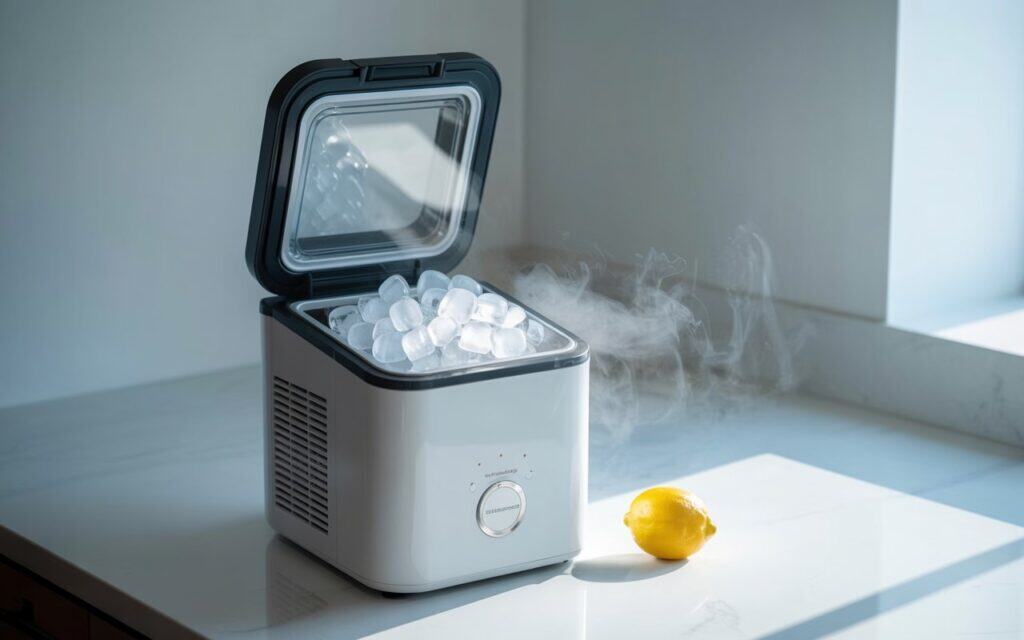
A portable ice maker works differently than what you’d find in a refrigerator. It uses conduction—metal prongs or rods get super cold, and water wraps around them to freeze into bullet-shaped ice. No built-in freezer here; once the ice is made, it sits in a bin and slowly melts unless you use it or move it to your freezer.
These machines are great for quick batches, but they don’t store ice long-term.
If you’re curious about how to properly operate a portable ice maker after understanding how it works, check out our full beginner’s guide on how to use an ice maker.
Refrigerator Ice Makers
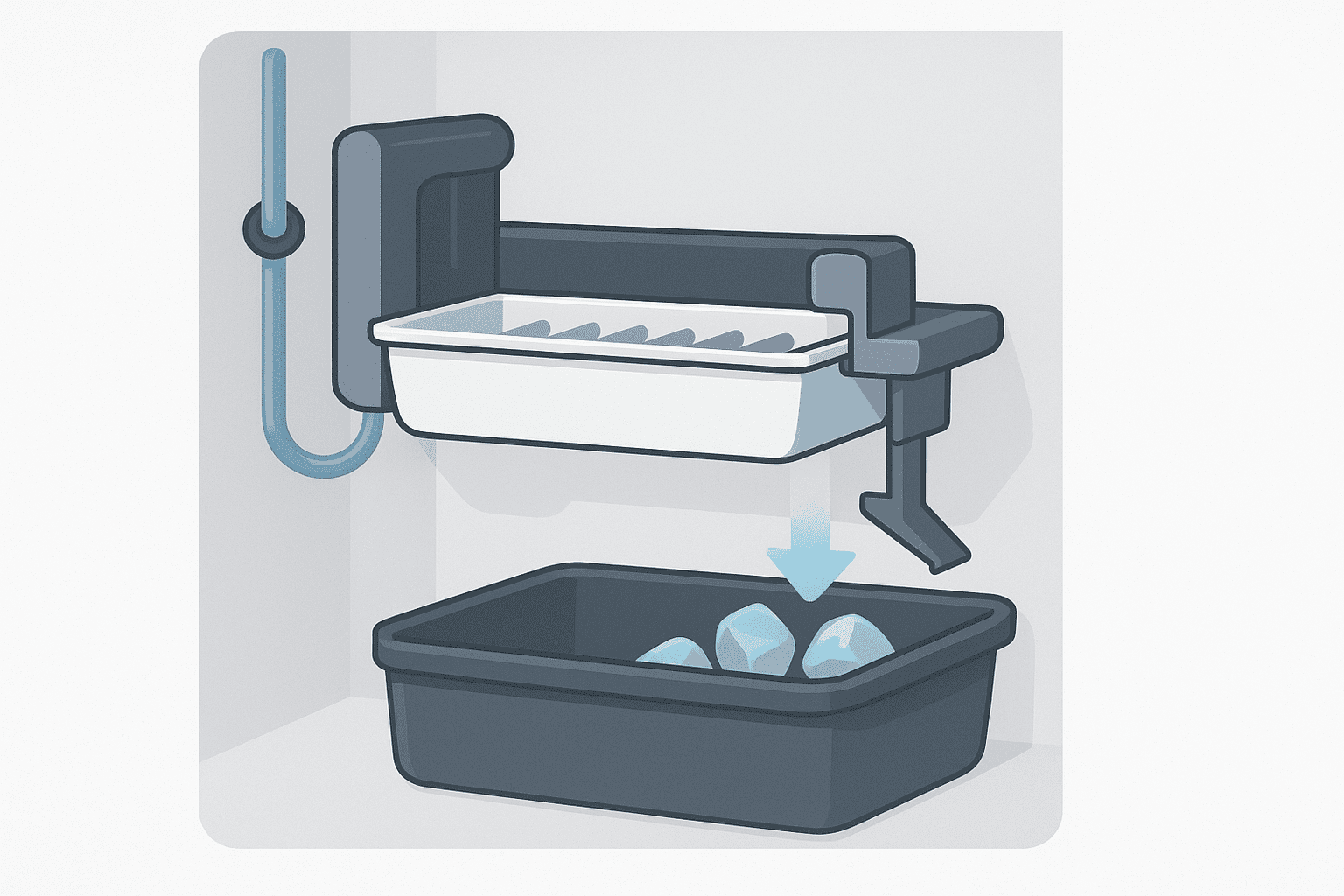
The refrigerator ice maker is the most common type in modern kitchens. It’s connected directly to a water line, which means it can refill itself without any input from you. Once the internal tray is full, a timer or sensor kicks in to freeze the water and drop the ice into a storage bin.
From experience, these are incredibly convenient—but if the water line gets blocked or the sensor fails, the whole process stops. That’s why regular maintenance matters.
Unlike portable units, this type is almost entirely automatic, making it ideal for everyday use with minimal effort.
Countertop Ice Makers
A countertop ice maker works almost like a portable unit—but with a few upgrades. These models often come with a larger water reservoir, faster production speed, and sometimes even a self-cleaning function. They’re perfect for families or shared spaces where you need more ice throughout the day.
While they don’t keep ice frozen for long either, the added capacity and features make a noticeable difference if you’re using it regularly.
What Happens Step-by-Step (Making a Batch of Ice)
Even the most advanced ice makers follow the same basic steps—just faster and more efficiently than freezing trays in your freezer.
- Water Intake: The machine draws water from its reservoir or a connected water line, depending on the type. Sensors detect when the level is just right.
- Freezing the Water: The water flows into an ice mold that’s pressed against a cold metal surface. The cooling element kicks in and gradually drops the temperature to start the freezing cycle.
- Shaping the Ice: As the water freezes, it takes the shape of the mold—round, bullet, crescent, or cube—depending on the design of the tray.
- Ejecting the Ice: Once fully frozen, a light heating element warms the mold just enough to loosen the ice, and a small motor pushes the cubes into the collection bin.
💡If your machine skips or delays any of these steps, it’s often a sign of a clogged line or faulty sensor—not necessarily a major malfunction.
How Long Does It Take to Make Ice?
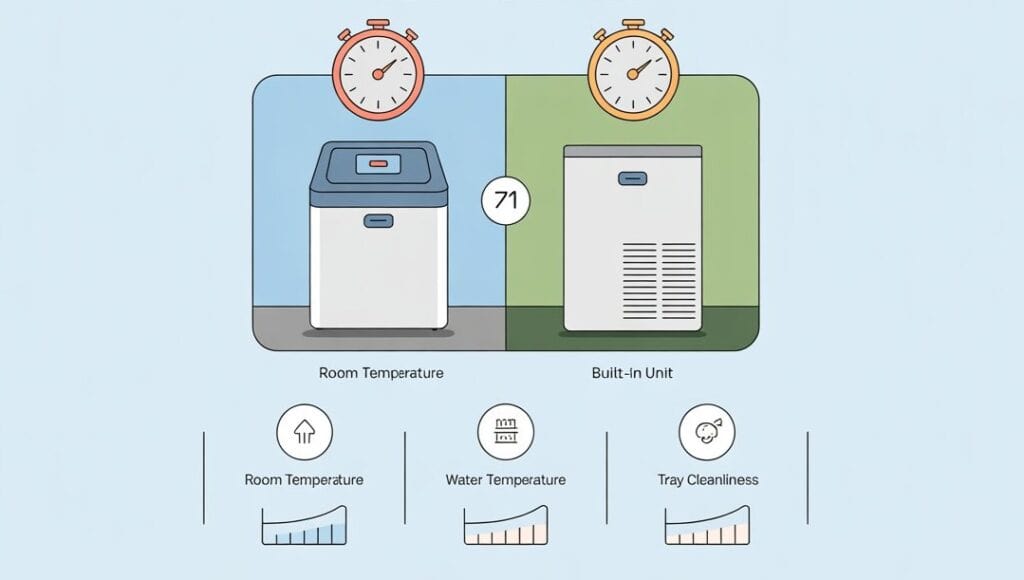
Most ice makers take anywhere from 6 to 20 minutes to produce a single batch, depending on the machine type and conditions. Portable units are usually faster but make smaller batches, while built-in models may take longer but produce more ice at once.
Several factors can affect ice production speed—including room temperature, water temperature, and how clean the internal parts are.
A clean reservoir and tray are essential for proper ice formation. For a safe, damage-free routine, here’s our guide on how to clean your ice maker.
Common FAQs About Ice Makers
Why does my ice maker stop working?
The most common reasons are a clogged water line, dirty sensors, or a full ice bin. Some machines pause automatically to avoid overflow or damage. A quick reset usually helps.
How to speed up ice production?
Use cold, filtered water and place the machine in a cool, well-ventilated spot. Also, avoid opening the lid too often—heat from the room slows down the freezing cycle.
Can I use filtered or distilled water?
Filtered water is ideal because it improves ice clarity and taste. Avoid distilled water unless the manual says it’s okay—some machines rely on mineral content for sensor accuracy.
Do I need a drain or water line?
It depends. Portable and countertop ice makers don’t need a drain or direct water line—they recycle unused water. But refrigerator and undercounter models usually require both.
Final Thoughts: Now That You Know How It Works…
Understanding how an ice maker works gives you a better sense of how to use it, clean it, and fix it when things go wrong. From water intake to freezing and release, the process is simpler than it seems—just a smart cycle repeated over and over.
Now that you know what’s happening inside, you’ll never look at your ice maker the same way again.

